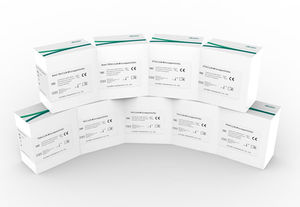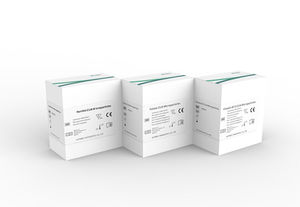
- Laboratory
- Laboratory medicine
- Osteoporosis test kit
- Autobio Diagnostics

- Company
- Products
- Catalogs
- News & Trends
- Exhibitions
Osteoporosis test kit CMS0102vitaminvitamin Dcalcium
Add to favorites
Compare this product
Characteristics
- Applications
- osteoporosis
- Tested parameter
- vitamin, vitamin D, calcium, phosphorus, potassium
- Sample type
- clinical, blood, urine, tissue
- Analysis mode
- biochemical
- Sample volume
0.05 ml, 0.1 ml
(0.00169 US fl oz, 0.00338 US fl oz)
Description
Bones are a type of tissue that undergoes very active metabolism. They can produce multiple metabolic products during molecule synthesis and degradation, and are regulated by multiple hormones. Clinically, assessing bone metabolism-related markers in the blood and urine can help evaluate the status of bone metabolism. Markers of bone metabolism include regular biochemical markers like phosphorus, calcium and potassium in blood, and regulatory hormones of bone metabolism like 25-hydroxy vitamin D (25OH-VD) and its metabolites, parathyroid hormone (PTH), calcitonin (CT) and also bone turnover markers like osteocalcin (OST).
Clinical Significance
OST is a bone-specific protein whose level reflects the activity of osteoblasts. Based on the variation of OST level, one can distinguish the type of osteoporosis to be either high-turnover or low-turnover.OST level can also be used to monitor the therapeutic effects of bone resorption inhibitors and bone growth stimulators.
Calcitonin (CT) is secreted by thyroid parafollicular cells (or named C cells), which has the primary function of reinforcing osteogenesis. Oestrogen can up-regulate the secretion of CT. Reduction of CT level could be a primary cause of the onset of postmenopausal osteoporosis. CT is an ultra-sensitive tumor marker in diagnosing medullary thyroid cancer (MTC). It can be used in the early preoperative diagnosis, postoperative follow-up and also treatment effectiveness evaluation of MTC.
25OH-VD is a steroid that supports the mineralization of osteoid and some other vitamins, hormones and minerals.It plays an important role in the formation and maintenance of strong bones.
Catalogs
No catalogs are available for this product.
See all of Autobio Diagnostics‘s catalogsExhibitions
Meet this supplier at the following exhibition(s):

Related Searches
- Autobio Diagnostics test kit
- Solution reagent kit
- Autobio Diagnostics blood test kit
- Autobio Diagnostics serum test kit
- Plasma assay kit
- Infectious disease detection kit
- Diagnostic reagent kit
- Respiratory infection test kit
- Autobio Diagnostics clinical test kit
- COVID-19 detection kit
- Clinical chemistry analyzer
- Bacteria reagent kit
- Antigen assay kit
- Clinical reagent kit
- IgG test kit
- Automatic clinical chemistry analyzer
- Benchtop clinical chemistry analyzer
- Laboratory detection kit
- Autobio Diagnostics cell test kit
- Microbiology reagent kit
*Prices are pre-tax. They exclude delivery charges and customs duties and do not include additional charges for installation or activation options. Prices are indicative only and may vary by country, with changes to the cost of raw materials and exchange rates.


